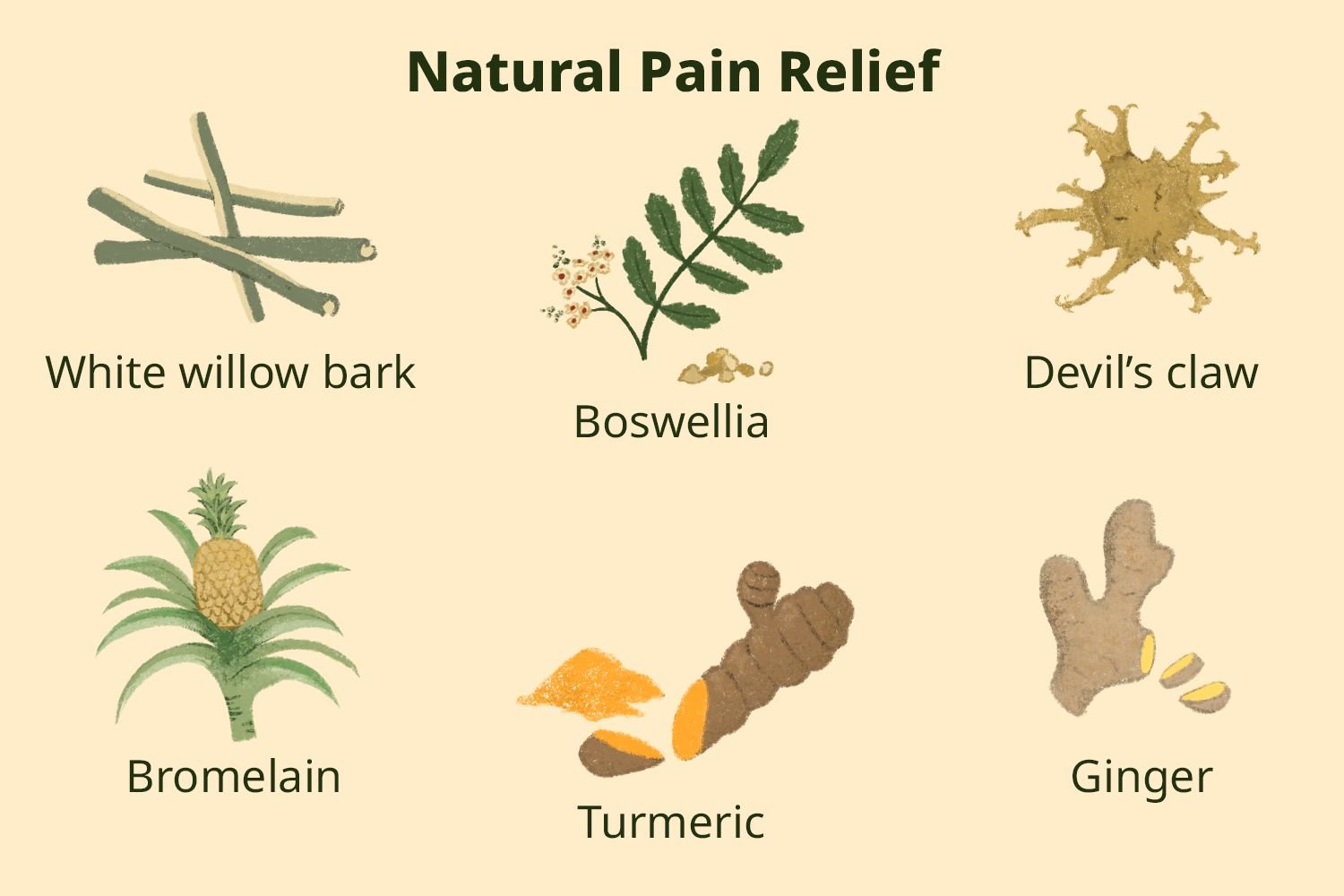Introduction
The pursuit of pain relief has always been a fundamental aspect of human existence. From the ancient civilizations to modern societies, people have sought various means to alleviate discomfort and promote well-being. In recent years, however, there has been an undeniable surge in the interest and utilization of natural pain relief remedies.
This growing fascination is driven by the desire to find alternatives to conventional medications that often come with unwanted side effects. Herbal remedies have garnered significant attention as a safe and effective alternative for pain relief.
With roots deeply embedded in traditional medicine practices across cultures, these natural solutions offer a holistic approach to managing discomfort without relying on synthetic compounds or invasive procedures. Recognizing the importance of herbal remedies can provide individuals with a broader perspective on their health journey and empower them to explore options beyond mainstream pharmaceutical interventions.
Brief Overview of the Increasing Interest in Natural Pain Relief Remedies
The rise in interest surrounding natural pain relief remedies is primarily driven by two factors: dissatisfaction with conventional treatments and a growing body of scientific evidence supporting the efficacy of herbal solutions. Many individuals find themselves dissatisfied with prescription medications that may alleviate pain but often come bundled with detrimental side effects such as addiction or compromised organ function.

This dissatisfaction has prompted people to turn towards alternative options, seeking out more natural approaches that can provide relief without sacrificing their overall well-being. Moreover, an increasing number of studies have shed light on the potential benefits of herbal remedies for managing pain effectively.
Importance of Herbal Remedies as a Safe and Effective Alternative to Conventional Medications
The significance attributed to herbal remedies lies within their ability to address pain while minimizing adverse effects on one’s health. Unlike many conventional medications, which may introduce synthetic chemicals into the body, herbal remedies leverage nature’s own pharmacological resources. These remedies utilize the inherent properties of plants, such as their anti-inflammatory, analgesic, and sedative qualities.
By working synergistically with the body’s natural processes, herbal remedies offer relief from pain in a manner that is gentler and more balanced, minimizing the risk of complications or long-term damage. Furthermore, herbal remedies often possess a broader spectrum of benefits compared to conventional medications that may focus solely on symptom management.
These natural solutions frequently tackle underlying causes of pain, offering not just temporary relief but also promoting overall healing and well-being. In doing so, they align with the principles of holistic health by addressing both physical discomfort and emotional imbalances.
Understanding Pain and Herbal Remedies
The Complexities of Pain: Exploring Acute, Chronic, and Inflammatory Discomforts
Pain, an intricate web of sensory perception, is a universal human experience. To comprehend how herbal remedies alleviate pain naturally, it is crucial to understand the different types of pain and their underlying mechanisms. First, there is acute pain, which arises suddenly and typically lasts for a short duration.
It often serves as a protective response to injury or tissue damage. On the other hand, chronic pain persists for longer periods, sometimes even beyond the expected healing time.
It can be debilitating and greatly impact one’s quality of life. Inflammatory pain occurs due to inflammation in the body’s tissues caused by various factors such as injury or certain medical conditions like arthritis.
This type of pain often involves redness, swelling, and heat around the affected area. Understanding these distinctions allows us to explore how herbal remedies function uniquely within each context.
Delving into Nature’s Pharmacy: Herbal Remedies Alleviating Pain Naturally
Herbal remedies provide an alternative approach to conventional medications for managing pain while minimizing potential side effects. These natural solutions harness the power of plants that have been used for centuries in traditional medicine systems across cultures worldwide.
One way herbal remedies alleviate pain naturally is through their interaction with our body’s receptors and neurotransmitters. Many herbs contain active compounds that bind with specific receptors in our nervous system, modulating the transmission of pain signals from peripheral nerves to the brain.
By interfering with these pathways, herbal remedies can effectively reduce our perception of discomfort. Moreover, several medicinal plants possess anti-inflammatory properties that contribute significantly to their analgesic effects.
Inflammation accompanies many painful conditions and contributes to both acute and chronic discomforts like arthritis or muscle strains. Herbal remedies rich in bioactive compounds attenuate inflammation by inhibiting pro-inflammatory enzymes and molecules, ultimately reducing pain and swelling.
Unveiling the Symphony Within: The Intricate Dance of Receptors and Inflammatory Pathways
The human body is a symphony of intricate interactions between receptors, neurotransmitters, and inflammatory pathways. Herbal remedies harmonize with these biological symphonies, providing a natural means of pain relief. When we experience pain, specialized receptors in our nerves called nociceptors get activated.
These nociceptors send signals to the brain, alerting us to potential tissue damage. Herbal remedies work by interacting with these receptors in various ways.
Some compounds may block the activation of nociceptors or inhibit the release of neurotransmitters responsible for transmitting pain signals. Others modulate receptor activity or enhance the release of endogenous opioids – naturally occurring substances that alleviate pain and induce feelings of well-being.
Additionally, herbal remedies possessing anti-inflammatory properties intervene in the cascades of inflammation by inhibiting enzymes like cyclooxygenase (COX) or lipoxygenase (LOX). By doing so, they reduce the production of pro-inflammatory molecules such as prostaglandins and leukotrienes that contribute to pain sensitization.
From Willow to Turmeric: A Tapestry Woven with Nature’s Pain-Relieving Allies
Within nature’s abundant palette lies a wide array of herbal allies renowned for their analgesic properties. From willow bark containing salicylic acid—a precursor to aspirin—to turmeric’s curcumin—a potent anti-inflammatory compound—the world is replete with botanical treasures awaiting discovery.
These herbal remedies not only offer relief from discomfort but also carry centuries-old wisdom passed down through generations across different cultures. As science continues to unravel their mechanisms at a molecular level, we gain profound insights into how these gifts from nature interact synergistically with our bodies’ intricate systems.
Understanding the multifaceted nature of pain and the mechanisms through which herbal remedies alleviate discomfort enlightens us on the power of natural solutions. With this knowledge in hand, we can explore specific herbal remedies that hold promise in providing safe and effective relief from various types of pain, paving the way for a more holistic approach to healthcare.
Top 6 Herbal Remedies for Natural Pain Relief
Turmeric (Curcuma longa)
Turmeric, derived from the Curcuma longa plant, has been used in traditional medicine for centuries. Its vibrant yellow color and distinct flavor make it a popular spice in many cuisines.
However, turmeric is not just a culinary delight but also a potent herbal remedy for pain relief. The active compound responsible for turmeric’s pain-relieving properties is curcumin.
Curcumin has been widely studied for its anti-inflammatory effects and its ability to modulate pain pathways in the body. By interacting with various receptors and neurotransmitters, curcumin can help alleviate joint pain, arthritis symptoms, and reduce inflammation.
Research suggests that regular consumption of turmeric or curcumin supplements can significantly improve joint flexibility and reduce swelling associated with conditions like rheumatoid arthritis or osteoarthritis. Additionally, the antioxidant properties of curcumin contribute to its overall health benefits by protecting cells from damage caused by oxidative stress.
Willow Bark (Salix spp.)
For centuries, willow bark has been recognized as a natural analgesic and used to relieve pain. The historical use of willow bark dates back to ancient civilizations such as the Egyptians and Greeks who utilized its healing properties.
The primary compound responsible for its pain-relieving effects is salicylic acid, which is closely related to aspirin. Salicylic acid works by inhibiting prostaglandins—a group of compounds that promote inflammation—thus reducing pain signals sent to the brain.
Willow bark has shown efficacy in treating various types of pain, including headaches, backaches, menstrual cramps, and even osteoarthritis. It provides a gentle approach to pain relief, often with fewer side effects compared to over-the-counter pain medications.
Ginger (Zingiber officinale)
Ginger, known for its unique flavor and aroma, is not only a delightful addition to culinary creations but also possesses notable anti-inflammatory properties making it an effective herbal remedy for pain relief. The active compounds gingerol and shogaol are believed to be responsible for ginger’s pain-relieving effects.
Gingerol acts as a potent antioxidant and has been shown to inhibit the production of pro-inflammatory compounds in the body. Shogaol, on the other hand, exhibits analgesic properties by blocking certain pain receptors.
Research suggests that ginger can alleviate various types of pain, including muscle soreness, migraines, and osteoarthritis. Regular consumption of ginger or its supplementation has shown promising results in reducing pain intensity and improving mobility in individuals with arthritis.
Valerian Root (Valeriana officinalis)
Valerian root has a long history of traditional use for promoting relaxation and improving sleep quality. However, it also offers analgesic properties that can help relieve nerve-related pains such as sciatica or neuropathy.
The main component responsible for valerian root’s analgesic effects is valerenic acid. Valerenic acid interacts with gamma-aminobutyric acid (GABA) receptors in the brain and spinal cord, which helps reduce nerve-related pain sensations.
This herbal remedy can be particularly beneficial for individuals experiencing chronic nerve pain conditions. Valerian root can offer natural relief without causing drowsiness or other side effects commonly associated with conventional medications used for nerve-related pains.
Conclusion
These top six herbal remedies provide excellent natural alternatives for pain relief. Turmeric, willow bark, ginger, and valerian root each offer unique compounds that target pain pathways in the body, reduce inflammation, and promote overall well-being.
By incorporating these herbal remedies into your lifestyle, you can harness their potent properties to alleviate pain naturally. However, it is always advisable to consult with a healthcare professional before starting any new herbal regimen to ensure safety and effectiveness for your specific condition. Embracing the power of nature’s remedies can bring a renewed sense of hope and optimism on the path towards holistic well-being. With these herbal allies by your side, you can embark on a journey of natural pain relief and nurture a greater connection with your body’s innate ability to heal.





